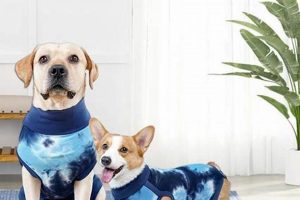The creation of customized resting spaces for canine companions, constructed by pet owners themselves, represents a growing trend in animal care. This approach involves utilizing readily available materials and personal skills to fabricate a sleeping area tailored to a specific animal’s size, breed, and comfort preferences. Examples include repurposed furniture, upcycled textiles, and hand-sewn cushions.
Providing an individualized sanctuary offers several advantages. It reduces reliance on mass-produced items, potentially saving costs and minimizing environmental impact through the reuse of materials. Furthermore, it allows for the accommodation of unique needs, such as orthopaedic support for aging dogs or hypoallergenic fabrics for sensitive skin. Historically, pet owners crafted similar items out of necessity; today, it reflects a desire for personalized care and creative expression.
The following sections will explore various methods for constructing these personalized canine retreats, detailing materials, techniques, and design considerations to enable successful implementation. These projects offer opportunities for skill development, resourcefulness, and an enhanced bond between pet and owner.
Construction Guidance
The following guidelines offer insights into effective fabrication and design practices. Diligent application of these recommendations can improve the finished product’s durability, comfort, and aesthetic appeal.
Tip 1: Material Selection: Prioritize durability and washability when choosing fabrics. Canvas, denim, and fleece offer resilience and ease of cleaning. Avoid materials containing small parts that could pose a choking hazard.
Tip 2: Structural Integrity: Ensure the frame, if utilizing one, is robust and capable of supporting the animal’s weight. Reinforce corners and edges to prevent premature wear and tear. Consider using non-toxic sealants or adhesives.
Tip 3: Sizing Considerations: Accurately measure the dog’s dimensions when lying down and standing. Add a buffer of several inches to allow for comfortable movement and stretching. A too-small space may discourage use.
Tip 4: Filling Material Options: Explore various filling materials, such as shredded memory foam, cedar shavings (for insect repellent properties), or hypoallergenic polyester fiberfill. Distribute the filling evenly to avoid lumps and ensure consistent support.
Tip 5: Accessibility Considerations: For senior dogs or those with mobility issues, design a low-profile entrance to facilitate easy access. Ramps or steps may be necessary to accommodate physical limitations.
Tip 6: Hygiene Maintenance: Incorporate a removable and washable cover to simplify cleaning. Regular washing helps prevent the buildup of dirt, allergens, and odors, promoting a healthier environment for the animal.
Tip 7: Safety Protocols: Securely fasten all components to prevent dislodgement or ingestion. Regularly inspect the finished product for signs of damage or wear. Repair or replace compromised elements promptly.
Adhering to these guidelines contributes to a finished product that provides comfort, safety, and longevity, benefiting both the animal and the pet owner.
The subsequent section will provide alternative design concepts, offering opportunities for creative expression and further customization.
1. Cost-effectiveness
Cost-effectiveness represents a significant motivator in the decision to construct customized resting places for canines. The financial implications of purchasing commercially available products often drive individuals to explore alternative, less expensive solutions.
- Repurposed Material Utilization
Employing repurposed materials, such as discarded textiles or used furniture, directly reduces expenses. Utilizing existing resources minimizes the need for new material purchases, thereby lowering the overall project cost. For example, an old sweater can be transformed into a cushion cover, or an unused shipping pallet can be repurposed as a bed frame.
- Labor Investment as Value
The time and effort invested in creating the item represent a form of labor that offsets monetary expenditure. While the activity requires personal resources, it avoids the mark-up associated with retail goods, where labor costs are incorporated into the final price. The value of this labor should be weighed against the time commitment required.
- Customization Eliminating Waste
Tailoring the design to the specific animal’s size and needs reduces material waste. Standardized products often contain excess material or features not required by the individual animal. By creating a bespoke solution, only the necessary materials are used, minimizing both financial and environmental costs.
- Durability Leading to Long-Term Savings
Constructing a robust item using durable materials can lead to long-term financial benefits. While the initial investment in higher-quality materials may be greater, the increased lifespan of the product reduces the frequency of replacements, resulting in overall savings compared to purchasing less durable, commercially available alternatives.
The various facets of cost-effectiveness demonstrate how constructing canine resting spaces can be a financially prudent decision. By leveraging repurposed materials, investing personal labor, customizing designs, and prioritizing durability, individuals can significantly reduce the financial burden associated with providing comfortable and functional accommodations for their pets. This approach balances financial considerations with the provision of personalized care.
2. Size customisation
Size customisation is a pivotal aspect of fabricating resting spaces for canines. It directly addresses the limitations of mass-produced items, which often fail to accommodate the diverse range of canine breeds and individual animal dimensions. This adjustment ensures optimal comfort and functionality.
- Breed-Specific Accommodations
Different breeds exhibit significant variations in size, body shape, and sleeping postures. A Chihuahua, for example, requires a far smaller resting area compared to a Great Dane. Size customisation facilitates the creation of spaces tailored to specific breed characteristics, preventing overcrowding or underutilization. The dimensions can be precisely adjusted to ensure the animal has ample room to stretch, turn, and rest comfortably.
- Addressing Physical Limitations
Canines with physical limitations, such as arthritis or hip dysplasia, may require accommodations that standard products do not provide. Size customisation allows for the creation of low-profile structures that are easier to access. It also enables the incorporation of supportive elements, such as orthopedic foam, precisely positioned to alleviate pressure points and provide enhanced comfort. This targeted support can improve the animal’s overall well-being and quality of rest.
- Adjusting to Individual Preferences
Individual canines, even within the same breed, may exhibit unique preferences for sleeping arrangements. Some prefer to curl up in tight spaces, while others prefer to sprawl out. Size customisation allows for the creation of spaces that cater to these individual preferences. Observing the animal’s sleeping habits can inform design decisions, resulting in a resting area that is optimally suited to its comfort and behavioral patterns.
- Optimizing Space Utilization
Customizing the size of the resting space optimizes the utilization of available space within the home. Standard products may be too large or too small for a given area, leading to inefficient use of space. Bespoke creations can be designed to fit specific dimensions, maximizing functionality without compromising the animal’s comfort or the aesthetic appeal of the environment. This approach is particularly beneficial in smaller living spaces where efficient use of area is critical.
These facets highlight the importance of size customisation. The capacity to precisely tailor the resting area contributes to a more comfortable and supportive environment. This contrasts sharply with the constraints imposed by standardized, commercially available items. Size customisation acknowledges the individuality of each animal and promotes the creation of functional and aesthetically appropriate spaces.
3. Material safety
The selection of safe materials is paramount in constructing resting places. A direct correlation exists between the materials used and the well-being of the animal. Inadequate material selection can lead to various health issues, ranging from allergic reactions to toxic exposure. Therefore, it represents a crucial component in the endeavor. For example, using fabrics treated with formaldehyde can cause skin irritation, while ingestion of small parts from degraded materials presents a choking hazard.
The practical significance of understanding this connection lies in preventing such adverse events. Opting for natural, untreated fabrics like organic cotton or hemp eliminates the risk of chemical exposure. Similarly, utilizing non-toxic filling materials, such as shredded memory foam certified by CertiPUR-US, minimizes the potential for harmful off-gassing. Real-life incidents involving canines suffering from dermatitis due to chemically treated bedding underscore the importance of diligence in material sourcing and selection.
In summation, material safety is not merely a desirable attribute but a necessity when constructing structures. Prioritizing non-toxic, durable, and easily cleanable materials mitigates risks and promotes a healthier environment. The challenge lies in thoroughly researching material composition and sourcing from reputable suppliers. This commitment to material safety directly contributes to the overall well-being and longevity of the animal using the item.
4. Durability enhancement
Durability enhancement is a key consideration when crafting canine resting spaces. The longevity of the constructed item is directly related to the materials and techniques employed. Without adequate attention to durability, the item will likely degrade quickly, necessitating frequent repairs or replacements, negating the economic and environmental benefits sought through the construction process. For example, a structure assembled with weak seams or easily torn fabric will quickly succumb to the wear and tear inflicted by canine activity. Therefore, an emphasis on robust construction methods is essential to maximize the item’s lifespan.
Strategies for enhancing durability encompass several key areas. Reinforcing seams with multiple rows of stitching, utilizing heavy-duty fabrics resistant to tearing and abrasion, and incorporating protective coatings to prevent moisture damage are all effective measures. Selecting hardware, such as zippers or fasteners, that are rated for heavy use also contributes to the overall resilience of the structure. Furthermore, considering the animal’s behavior, such as chewing habits, and incorporating design elements to mitigate potential damage, such as reinforced corners, is critical. The absence of these features can significantly reduce the item’s functional life. For example, a bed lacking a waterproof liner will quickly become soiled and unusable due to accidents or spills.
In summation, durability enhancement is not merely a cosmetic consideration but a fundamental requirement for a successful and sustainable canine resting space. The implementation of robust construction techniques, the selection of durable materials, and the anticipation of potential wear points are essential for maximizing the item’s lifespan and ensuring long-term value. The investment in durability directly translates into reduced waste, lower replacement costs, and a more comfortable and secure environment for the animal. This approach aligns with the principles of resourcefulness and responsible pet ownership.
5. Hygiene control
Maintaining cleanliness in canine resting spaces is of paramount importance for the health and well-being of the animal. When constructing such spaces, hygiene control becomes an inherent design consideration rather than an afterthought.
- Removable and Washable Covers
The incorporation of removable and washable covers constitutes a fundamental aspect of hygiene control. These covers serve as the primary barrier against dirt, allergens, and parasites. Regular laundering effectively eliminates these contaminants, preventing their accumulation and potential transmission to the animal. The ease of removal and washing significantly reduces the labor involved in maintaining a sanitary environment. An illustrative example is the use of zippered covers made from durable, machine-washable fabrics such as canvas or denim. Without this feature, thorough cleaning becomes significantly more challenging, potentially compromising hygiene standards.
- Water-Resistant Liners
The inclusion of water-resistant liners underneath the main cover acts as a secondary defense against spills and accidents. These liners prevent moisture from penetrating the inner filling, which can harbor bacteria and mold. Materials like polyurethane laminate (PUL) offer a breathable yet impermeable barrier, protecting the inner components from contamination. The practical application of this feature is particularly relevant for puppies or senior dogs prone to incontinence. Without a water-resistant liner, the filling material is susceptible to saturation, leading to unpleasant odors and potential health risks.
- Antimicrobial Materials
The strategic use of antimicrobial materials can further enhance hygiene control. Fabrics and filling materials treated with antimicrobial agents inhibit the growth of bacteria, fungi, and other microorganisms. These agents can be incorporated directly into the fibers or applied as a topical treatment. Examples include silver-infused fabrics or cedar shavings used as filling. While not a substitute for regular cleaning, antimicrobial materials provide an additional layer of protection against microbial proliferation, contributing to a more hygienic environment.
- Ventilation and Airflow
The design of the structure should promote adequate ventilation and airflow. Stagnant air can trap moisture and odors, creating a breeding ground for bacteria. Incorporating breathable fabrics and avoiding enclosed, airtight designs allows for air circulation, reducing the risk of microbial growth. For instance, utilizing a raised platform or mesh panels can improve ventilation. This design element is particularly important in humid environments where moisture accumulation is a significant concern. Proper ventilation complements other hygiene control measures, promoting a healthier and more comfortable resting space.
These considerations underscore the importance of hygiene control. The proactive integration of features that facilitate cleanliness contributes to a healthier and more comfortable resting space. This is a key advantage when building your own, since you can ensure these points are covered.
6. Aesthetic integration
Aesthetic integration, in the context of canine resting spaces, refers to the harmonious blending of the structure’s design with the existing interior decor. This consideration extends beyond mere functionality, addressing the visual impact of the item within the living environment. The cause-and-effect relationship is evident: a well-integrated structure enhances the room’s overall aesthetic, while a poorly designed one detracts from it. Its importance as a component lies in its contribution to the homeowner’s satisfaction and the perceived value of the customized item. Examples include matching fabric patterns to existing furniture, selecting colors that complement the room’s palette, or incorporating design elements that reflect the home’s architectural style. Failure to consider this can result in a discordant element, diminishing the room’s aesthetic appeal.
The practical significance manifests in several ways. A cohesive design can elevate the perception of pet ownership, presenting the animal’s accommodations as a deliberate and stylish addition to the home rather than a haphazard afterthought. This careful curation contributes to a more polished and refined living space. Conversely, neglecting this aspect can lead to visual clutter and a diminished sense of order. Furthermore, aesthetic integration can indirectly influence the animal’s well-being. A visually appealing and comfortable resting space may encourage its consistent use, promoting restful sleep and reducing anxiety. The structure’s design, therefore, contributes to both the human and animal experience of the home.
In summary, aesthetic integration represents a crucial, albeit often overlooked, aspect. It demands a thoughtful approach to design, considering color palettes, materials, and overall style. The challenge lies in balancing the animal’s needs with the homeowner’s aesthetic preferences. This balance ensures the constructed structure is not only functional and comfortable but also a visually pleasing addition to the living environment. Its significance extends beyond mere appearances, contributing to the overall harmony and well-being of the home.
7. Orthopedic support
The provision of orthopedic support is a critical function of canine resting spaces, particularly for aging animals or those with pre-existing musculoskeletal conditions. When constructing customized canine resting spaces, the incorporation of orthopedic support becomes a paramount design consideration. The cause-and-effect relationship is direct: inadequate support can exacerbate existing joint pain and contribute to the development of new orthopedic issues, while appropriate support alleviates pressure, promotes proper spinal alignment, and improves overall comfort. The importance of orthopedic support stems from its ability to enhance the animal’s quality of life and mobility. Examples of this include the use of memory foam or high-density foam inserts to distribute weight evenly and reduce stress on joints. A practical understanding is essential to prevent harm and promote animal welfare.
The application of orthopedic principles translates into several practical considerations during the construction phase. Selecting appropriate materials is crucial; high-density foam or memory foam provides superior support compared to traditional fiberfill. The thickness and density of the foam should be tailored to the animal’s weight and size to ensure adequate compression and weight distribution. Layering different types of foam can optimize support and comfort. For instance, a base layer of high-density foam can provide stability, while a top layer of memory foam conforms to the animal’s body contours. The construction should also consider the animal’s specific orthopedic needs. Elevated edges or bolsters can provide additional support for the neck and back, while a low-profile design facilitates easy access for animals with limited mobility.
In summation, orthopedic support is a key function when constructing canine resting spaces, particularly for animals with musculoskeletal issues. Incorporating high-quality materials and construction techniques is essential for creating a supportive and comfortable environment. This demonstrates a commitment to animal well-being and responsible pet ownership. The challenge lies in accurately assessing the animal’s individual needs and selecting materials that meet those requirements. Prioritizing orthopedic support ensures that the constructed structure not only provides a place to rest but also promotes long-term joint health and overall mobility.
Frequently Asked Questions
The following questions address common concerns and misconceptions regarding the construction of customized canine resting spaces. The information aims to provide clarity and guidance for individuals considering this endeavor.
Question 1: What materials are unsuitable for use in a constructed resting space due to potential toxicity?
Certain materials pose a risk of toxicity if ingested or through skin contact. Treated lumber, pressure-treated fabrics, and materials containing lead-based paints should be avoided. Additionally, small, detachable parts can present a choking hazard and should be excluded from the design.
Question 2: How can the size of the structure be accurately determined to ensure adequate space for the animal?
Measuring the animal’s length while lying down in a relaxed position provides a baseline measurement. Add several inches to this length to allow for stretching and movement. The width should also accommodate the animal’s breadth when lying down. Consider the animal’s preferred sleeping posture when determining dimensions.
Question 3: What are the best practices for maintaining hygiene in the constructed resting space to prevent the accumulation of allergens and odors?
Utilizing removable and washable covers is essential for hygiene maintenance. Regular laundering of these covers eliminates dirt, allergens, and odors. Water-resistant liners can prevent moisture from penetrating the inner filling. Periodic vacuuming of the structure also helps remove loose debris and allergens.
Question 4: What construction techniques can be employed to enhance the durability and longevity of the constructed resting space?
Reinforcing seams with multiple rows of stitching, utilizing heavy-duty fabrics resistant to tearing, and incorporating protective coatings to prevent moisture damage are all effective strategies. Selecting robust hardware, such as zippers and fasteners, also contributes to durability.
Question 5: How can orthopedic support be effectively integrated into the design to benefit aging or arthritic animals?
Utilizing high-density foam or memory foam inserts provides superior support compared to traditional fiberfill. The thickness and density of the foam should be tailored to the animal’s weight and size. Elevated edges or bolsters can provide additional support for the neck and back.
Question 6: What are the key considerations for ensuring the structure integrates harmoniously with the existing interior decor?
Matching fabric patterns to existing furniture, selecting colors that complement the room’s palette, and incorporating design elements that reflect the home’s architectural style contribute to aesthetic integration. The structure should be viewed as a deliberate and stylish addition to the living space.
These questions and answers address the most pressing concerns related to the construction of canine resting spaces. The knowledge provided aids in decision-making and design implementation.
The subsequent section will provide a summary encompassing all main concepts discussed previously, offering a comprehensive overview.
Conclusion
This exploration of “diy dog bed” construction has illuminated several critical facets. From cost-effectiveness and size customization to material safety, durability enhancement, hygiene control, aesthetic integration, and orthopedic support, each element contributes significantly to the creation of a functional and beneficial resting space. The principles outlined offer a foundation for informed decision-making and skillful implementation.
As pet owners increasingly seek personalized solutions tailored to their animal’s specific needs, the practice of constructing individualized resting spaces will likely gain further traction. The principles articulated in this discussion serve as a call to responsible craftsmanship, urging individuals to prioritize the well-being and comfort of their canine companions. Continued adherence to these guidelines promotes a harmonious balance between functionality, aesthetics, and animal welfare, ensuring the constructed structures fulfill their intended purpose effectively and ethically.


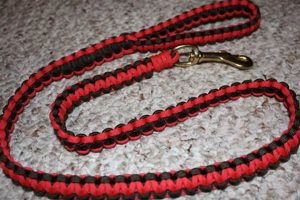
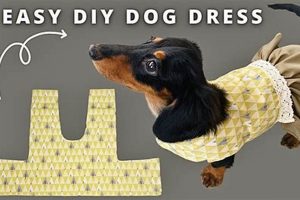
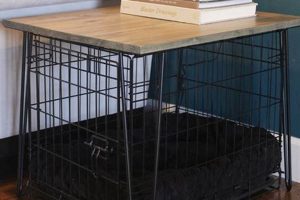
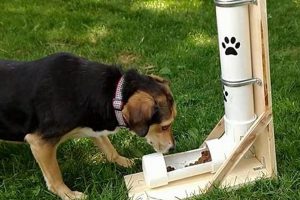
![Build a Safe Sliding Dog Gate DIY [Easy Steps!] The DIY Hub: Creative Crafts, Repairs & Life Hacks Build a Safe Sliding Dog Gate DIY [Easy Steps!] | The DIY Hub: Creative Crafts, Repairs & Life Hacks](https://craftingdiycenter.com/wp-content/uploads/2025/07/th-2861-300x200.jpg)
